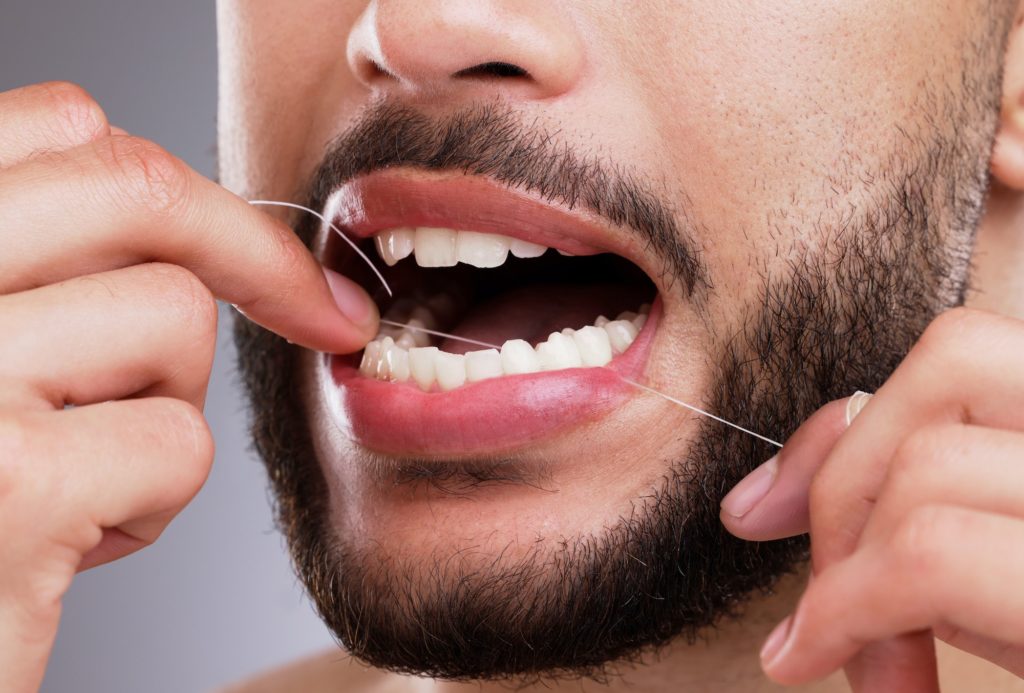The Best Way to Floss Your Teeth

“Make sure you floss!” is a saying you’ve probably heard your dentist say too many times to keep track. But it’s said for good reason. Flossing is an important part of oral hygiene that is often forgotten. Statistics show less than 40% of Americans floss every day. That’s a lot of people who don’t even realize how much plaque is getting stuck to their teeth every day.
Table of Contents
Why Should You Floss?
Flossing gets those small particles of food that get stuck in between your teeth. If food particles stay in between your teeth, it gives bacteria something to feed on; thus, more bacteria will grow on your teeth. The plaque will build up and trap bacteria on its sticky surface. The bacteria release acid that breaks down your enamel and leads to cavities and tooth decay. All these complications from not flossing make you more susceptible to gum disease.
How to Floss the Right Way?
It’s a great step in the right direction to floss every day, but it’s important to floss correctly.
Flossing incorrectly can damage your gums and teeth. Luckily for you, here’s a guide on how to floss correctly. Improper flossing can potentially damage your teeth and gums. So, if you’re unsure about the right way to clean your teeth, here’s a step-by-step guide on the best way to floss.
Step one: Cut a piece of floss about two feet. To get a nice grip, wrap the floss around both of your middle fingers until there is a one or two-inch piece of floss left.
Step two: Next, slide the dental floss in between the two teeth you want to clean. Softly slide the floss up and down and against both sides of your teeth. Be careful not to it your gums too hard as it can damage them.
Step three: When the floss gets close to your gums, make a curve in the floss to form a U shape, allowing the floss to enter the space between your gums and your tooth.
Step four: Repeat these steps on your other teeth after cleaning each tooth. Remember to use a different section of floss as you move to different teeth.
When Should You Floss?
Flossing at the right time is an important part of flossing that is often overlooked. Many people will brush and then floss, but this is the wrong way to do it. You should floss before brushing to get rid of food and plaque stuck between your teeth. Once the particles are detached from your teeth, the brush can easily wipe them away. Brushing first and then flossing after will cause food and plaque remains on your teeth. Be sure to floss your teeth first, then brush them, for optimal cleaning.
How to Floss with Braces?
While it can be difficult to floss with braces, it is still important! There are methods that can help you keep your mouth clean and healthy, even with braces. Read our article about flossing with braces to learn more and keep your braces and teeth healthy and clean.
What are the Types of Dental Floss?
There are a variety of dental flosses, each with its own special abilities and attributes. Here are the different types of floss:
- Dental tape – for large gaps in your teeth. This is a flat and wider type of floss that looks like a piece of tape.
- Standard floss- your classic floss. Super thin, comes flavored or unflavored, and is great for tight areas.
- Super flosses – Floss for braces and dental appliances.
Hopefully, this helped you learn a thing or two about flossing! Flossing prevents gum disease, cavities, bad breath, and much more. Think about all the tiny food particles that your brush cannot get to. It’s a bacteria-feeding ground. Flossing twice daily before you brush will maintain great oral hygiene and a beautiful, healthy smile.
Floss FAQs
Floss is a dental hygiene practice involving using a thin thread or filament to clean the spaces between teeth. Maintaining oral health and preventing dental issues such as cavities and gum disease is important. Plaque and food particles not accessible by simply brushing your teeth can be removed by flossing.
By sliding the floss gently between each tooth and along the gumline, individuals can effectively remove debris and bacteria, promoting a cleaner and healthier mouth. Regular flossing, brushing, and regular dental check-ups are recommended for optimal dental hygiene.
As part of a thorough oral care regimen, flossing should be done daily. Every day brushing is necessary to eliminate plaque, food fragments, and bacteria that can collect in the gaps between teeth and along the gumline. By flossing daily, you can prevent the buildup of plaque, which can lead to tooth decay, gum disease, and other oral health issues. It is recommended to floss before or after brushing your teeth, ensuring that you reach all the interdental spaces.
For individualized guidance on the frequency and technique of flossing depending on your particular oral health needs, speak with your dentist or dental hygienist.
Flossing is important for several reasons. Firstly, it helps remove plaque and food particles from the spaces between teeth and along the gumline that a toothbrush may not be able to reach effectively. If left unchecked, plaque, a sticky film of bacteria that builds on the teeth, can cause gum disease and tooth decay. Flossing can prevent plaque accumulation and reduce the risk of developing these oral health problems. Secondly, flossing promotes gum health, and it helps remove debris and bacteria that irritate the gums and cause inflammation or gum disease.
Maintaining healthy gums supports the overall health and stability of your teeth. Lastly, regular flossing can contribute to fresher breath by eliminating trapped food particles and bacteria that can cause unpleasant odors.
Generally speaking, it is advised to floss before cleaning your teeth. Flossing first helps remove plaque and food particles from between the teeth and along the gum line, making it easier for the toothbrush and toothpaste to reach all surfaces of the teeth. Brushing can effectively remove them from the mouth by loosening and dislodging debris with floss. Additionally, flossing before brushing enables toothpaste’s fluoride to penetrate between teeth and along the gum line, improving tooth decay protection.
